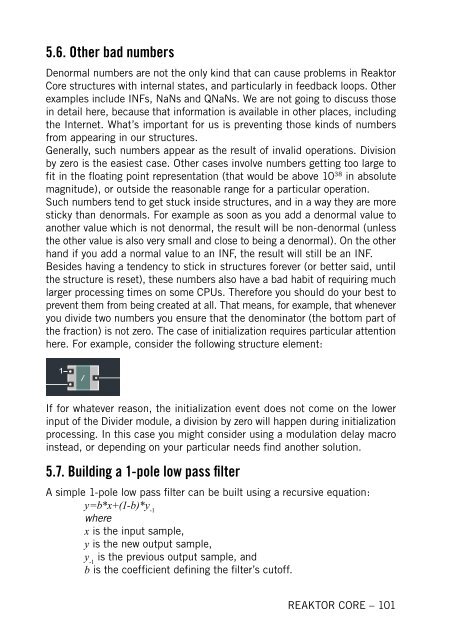1. First steps in Reaktor Core - Native Instruments
1. First steps in Reaktor Core - Native Instruments
1. First steps in Reaktor Core - Native Instruments
You also want an ePaper? Increase the reach of your titles
YUMPU automatically turns print PDFs into web optimized ePapers that Google loves.
5.6. Other bad numbers<br />
Denormal numbers are not the only k<strong>in</strong>d that can cause problems <strong>in</strong> <strong>Reaktor</strong><br />
<strong>Core</strong> structures with <strong>in</strong>ternal states, and particularly <strong>in</strong> feedback loops. Other<br />
examples <strong>in</strong>clude INFs, NaNs and QNaNs. We are not go<strong>in</strong>g to discuss those<br />
<strong>in</strong> detail here, because that <strong>in</strong>formation is available <strong>in</strong> other places, <strong>in</strong>clud<strong>in</strong>g<br />
the Internet. What’s important for us is prevent<strong>in</strong>g those k<strong>in</strong>ds of numbers<br />
from appear<strong>in</strong>g <strong>in</strong> our structures.<br />
Generally, such numbers appear as the result of <strong>in</strong>valid operations. Division<br />
by zero is the easiest case. Other cases <strong>in</strong>volve numbers gett<strong>in</strong>g too large to<br />
fit <strong>in</strong> the float<strong>in</strong>g po<strong>in</strong>t representation (that would be above 10 38 <strong>in</strong> absolute<br />
magnitude), or outside the reasonable range for a particular operation.<br />
Such numbers tend to get stuck <strong>in</strong>side structures, and <strong>in</strong> a way they are more<br />
sticky than denormals. For example as soon as you add a denormal value to<br />
another value which is not denormal, the result will be non-denormal (unless<br />
the other value is also very small and close to be<strong>in</strong>g a denormal). On the other<br />
hand if you add a normal value to an INF, the result will still be an INF.<br />
Besides hav<strong>in</strong>g a tendency to stick <strong>in</strong> structures forever (or better said, until<br />
the structure is reset), these numbers also have a bad habit of requir<strong>in</strong>g much<br />
larger process<strong>in</strong>g times on some CPUs. Therefore you should do your best to<br />
prevent them from be<strong>in</strong>g created at all. That means, for example, that whenever<br />
you divide two numbers you ensure that the denom<strong>in</strong>ator (the bottom part of<br />
the fraction) is not zero. The case of <strong>in</strong>itialization requires particular attention<br />
here. For example, consider the follow<strong>in</strong>g structure element:<br />
If for whatever reason, the <strong>in</strong>itialization event does not come on the lower<br />
<strong>in</strong>put of the Divider module, a division by zero will happen dur<strong>in</strong>g <strong>in</strong>itialization<br />
process<strong>in</strong>g. In this case you might consider us<strong>in</strong>g a modulation delay macro<br />
<strong>in</strong>stead, or depend<strong>in</strong>g on your particular needs f<strong>in</strong>d another solution.<br />
5.7. Build<strong>in</strong>g a 1-pole low pass filter<br />
A simple 1-pole low pass filter can be built us<strong>in</strong>g a recursive equation:<br />
y=b*x+(1-b)*y -1<br />
where<br />
x is the <strong>in</strong>put sample,<br />
y is the new output sample,<br />
y -1 is the previous output sample, and<br />
b is the coefficient def<strong>in</strong><strong>in</strong>g the filter’s cutoff.<br />
REAKTOR CORE – 101










